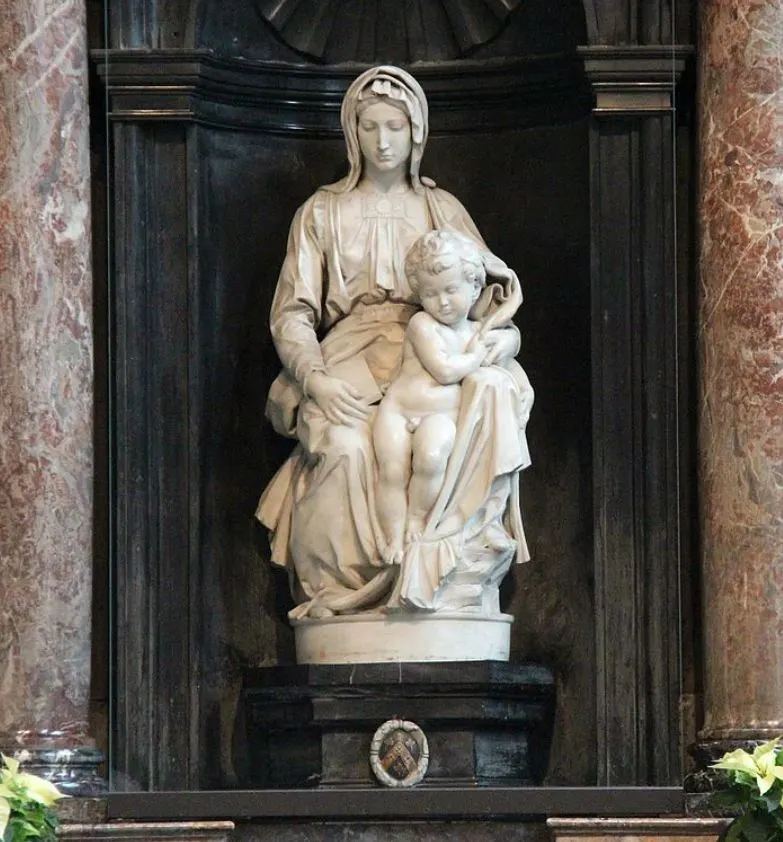The capital city of the West Flanders province of Belgium was once the most important city in Northern Europe, and this reflects in Bruges’ architecture.
Right in the medieval heart of this relatively small city stands one of the most amazing churches you’ll ever come across.
Not only does this fascinating Gothic cathedral in Bruges hold a remarkable record, but it also houses several works of art that were produced by the most renowned artists in history.
In this article, you’ll discover some of the most interesting facts about the Church of Our Lady in Bruges, a structure with several remarkable stories to tell.
1. It’s located just south of the historic city center of Bruges
Bruges is one of the many cities that is often referred to as the “Venice of the North.” That’s because there are many canals that flow through the heart of the city.
Right next to where you can hop on a boat that allows you to discover some of the city’s most stunning landmarks you can find the most prominent building in Bruges.
The Church of Our Lady is situated just south of the historical heart of Bruges. This is marked by the “Grote Markt,” the main market square where you can find the Belfry of Bruges.
The picturesque medieval Boniface Bridge is located right next to it and just a bit further you can find the Groeningemuseum, a museum that houses some remarkable Flemish paintings.

2. The first stone of the church was laid in the 13th century
Bruges is the capital city of the West Flanders Province in Belgium but it’s a fairly small city with a population of fewer than 120,000 inhabitants.

During the Middle Ages, the city became one of the most important port cities in Northern Europe and it became the capital of the County of Flanders in 1089.
Although it later lost its position to Ghent, Antwerp, and Brussels, many amazing feats of architecture were constructed during this period of wealth.
The first stone of the Church of Our Lady was laid in the 13th century and the church’s choir was completed between 1270 and 1280. Multiple additions were made during the 14th and 15th centuries.

3. The exterior was designed in the distinctive Gothic architectural style
The exterior of the building features Gothic architecture, the most popular architectural style in Europe during the Middle Ages.
The Gothic cathedral features a tall tower that flanks the northern part of the church. The flying buttresses that support the structure and the pointy spires are typical Gothic elements.
The roof of the building is supported by cross-vaults, all elements that date back to the initial construction phase.

4. Various elements of the interior were decorated in the Baroque style
Many additions were made to the interior, well into the 16th century. Several people were buried inside, including Charles the Bold (1433-1477) and his daughter Mary of Burgundy (1457-1482).
Their tombs were constructed in the 15th and 16th centuries and feature gilded bronze sculptures depicting the father and his daughter.
The interior looks similar to many other Gothic churches but it also features several feats of Baroque architecture, mainly chapels, that were added in later centuries.

5. The Church of Our Lady is by far the tallest building in Bruges
There’s no chance that you won’t find this amazing landmark in Bruges. That’s because the tower of the Church of Our Lady is by far the tallest building in the city.
Designed in the Gothic style which aimed to reach the Heavens above, the tower reaches a height of 115.6 meters (379 feet), a height that classifies it as a medieval skyscraper.
Today, it remains the third-tallest brickwork tower in the world. Only the towers of St. Mary’s Church in Lübeck and St. Martin’s Church in Landshut in Germany are taller.

6. It houses several paintings, including a masterpiece by a Flemish painter
Like most churches in Europe, the Church of Our Lady in Bruges houses some remarkable works of art. This definitely makes it worthwhile to enter it.
There’s a work titled “Supper at Emmaus” (1604) which was initially believed to be a painting by Caravaggio but this has been refuted.
Another Gothic painting titled “Deposition of the Cross” is a triptych that was painted by an anonymous painter.
The most notable painting inside the church is a world titled “Crucifixion” (1626) and has been attributed to Anthony van Dyck, one of the greatest Flemish artists in history.

7. The most stunning artwork inside the church is a sculpture by Michelangelo
The ultimate treasure at the church in Bruges is titled the “Madonna of Bruges.” It depicts the Virgin Mary and her infant Jesus Christ in a fantastic manner.
It’s the main altarpiece of the largest 18th-century Baroque chapel and was carved in the early 16th century by none other than Michelangelo.
It’s believed that he started working on it shortly after the slab of Carrara marble was quarried in 1505 and completed it just a year later.
The famous Renaissance artist was only in his early thirties back then and had just recently completed his world-famous Statue of David (1501-1504).

8. There’s a remarkable backstory about Michelangelo’s famous sculpture
First of all, this was the only sculpture by Michelangelo that left Italy during his lifetime. This alone is a remarkable story and hints at the fact that it wasn’t meant to be sent abroad.
It was commissioned by Florentine bankers Baldassare and Giovanni Balducci to decorate the Cathedral of Siena but there was a financial dispute.
Because it was impossible to be resolved, Michelangelo sold the sculpture to two merchants from Bruges named Jan and Alexander Mouscron.
The sculpture was transported to Bruges shortly after and placed in its current location in 1514.

